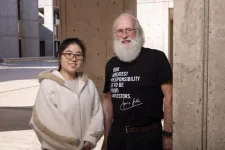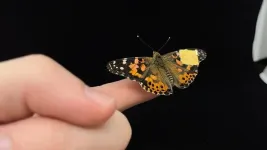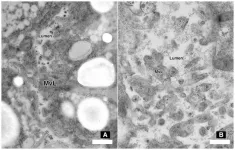(Press-News.org)
MEDIA INQUIRES
WRITTEN BY
Laura Muntean
Olga Kuchmentt
laura.muntean@ag.tamu.edu
601-248-1891
January 14, 2025 - by Olga Kuchment
Kiran Gadhave, Ph.D., Texas A&M AgriLife Research scientist and assistant professor in the Department of Entomology, Amarillo, is working on multiple projects to understand tomato spotted wilt virus. (Surender Kumar/Texas A&M AgriLife)
Texas A&M AgriLife Research scientists have received two grants from the U.S. Department of Agriculture and the National Science Foundation to develop better control and understanding of tomato spotted wilt virus, one of the top 10 most economically important plant viruses in the world.
Kiran Gadhave, Ph.D., AgriLife Research scientist and assistant professor in the Texas A&M College of Agriculture and Life Sciences Department of Entomology, Amarillo, will lead one grant and is a co-investigator on the other.
The most recent project and the one Gadhave is leading is funded by a three-year, $887,000 grant from the USDA Agricultural Marketing Service, USDA-AMS, will pursue research applications to develop better control of the pathogen.
A related three-year, $993,002 grant from the National Science Foundation and the USDA National Institute of Food and Agriculture will focus on understanding the virus on a fundamental level.
“We are tackling this problem from multiple perspectives, bringing in interdisciplinary expertise from different institutions,” Gadhave said.
Knowns and unknowns about the versatile virus
Tomato spotted wilt virus infects more than 1,000 plant species, including both specialty and staple food crops and weeds, causing an estimated $1 billion in crop losses worldwide each year.
A tomato and pepper leaves infected with tomato spotted wilt virus. (Senthilraja Chinnaiah/Texas A&M AgriLife)
Stunting, mosaic-like patterns on leaves, a lack of fruit, or rot-like spots on fruit are some of the symptoms of the disease in crops. Badly infected produce cannot be sold and is unpalatable.
Studies show the virus continues to change, and new strains have been reported in at least 10 countries.
“A single gene in tomatoes offers resistance against this virus,” Gadhave said. “But new virus strains have emerged, which our lab has reported, that have been breaking that resistance. So those virus-resistant tomato cultivars are not completely effective anymore.”
These “resistance-breaking” strains of the virus are of particular concern and will be a key focus of the new applied and basic research.
Another complication in combating the virus is its main insect vector, western flower thrips. This tiny insect is a damaging pest even on its own.
“The unique thing about this virus is that it can replicate in insect and plant hosts,” Gadhave said. “It’s a cross-kingdom virus.”
Yet another tricky thing about tomato spotted wilt virus is that it infects weeds, using them as a “green bridge” to cross into vulnerable crops, Gadhave said. “That’s where the virus stays when there is no crop around, and it’s why surveillance will be an important part of our work.”
Applied research
The applied USDA-AMS project serves many potential beneficiaries. It aims to help vegetable growers through new crop cultivars, new detection methods, and updated, science-based management recommendations. The results and outcomes will also inform future research and education.
In addition, given the global agricultural significance and economic impact of the tomato spotted wilt virus, the project will also help educate the public about agriculture, Gadhave said.
“Our project aims to inform the general public of the challenges that plant viruses and vectors present to global food and nutritional security.”
Joining Gadhave on the USDA-AMS grant are Texas A&M faculty members Xudong Rao, Ph.D., AgriLife Research associate professor, and Xingguo Wang, Ph.D., AgriLife Research assistant professor, both in the Department of Agricultural Economics and stationed in Fort Worth; and Kevin Crosby, Ph.D., AgriLife Research vegetable breeder and professor, Department of Horticultural Sciences, Bryan-College Station.
Other collaborators include Anna Whitfield, Ph.D., and Dorith Rotenberg, Ph.D., both professors at North Carolina State University in Raleigh; and Tomas Melgarejo, Ph.D., assistant project scientist at the University of California, Davis.
To tackle the formidable agricultural threat, the team on the USDA-AMS project will pursue six connected goals:
Surveillance of resistance-breaking virus strains in major tomato and pepper growing regions of the U.S.
With growers, estimate the economic losses due to the virus and calculate the cost-effectiveness of different management strategies.
Development of diagnostic tools to reliably and efficiently detect resistance-breaking virus variants.
Understanding the transmission biology of the resistance-breaking strains and identifying strategies to disrupt transmission.
Evaluating the impact of growing practices on disease transmission, including a comparison between high tunnels and open fields.
Developing new crop cultivars with strong resistance to resistance-breaking virus strains.
Fundamental research
Gadhave is also the co-principal investigator on the joint grant from the National Science Foundation and the USDA National Institute of Food and Agriculture. Funded through the NSF–NIFA Plant Biotic Interactions Program, this project will investigate how the resistance-breaking strains of the virus interact with the tomato at the molecular level.
While the USDA-AMS project will focus on applied science, the NSF-NIFA project’s scope is fundamental research. The principal investigator on that project is Hanu Pappu, Ph.D., Carl F. and James J. Chuey Endowed Chair and President Sam Smith Distinguished Professor in Plant Virology at Washington State University, Pullman.
“We want to understand how the new strains of the virus overcome the genetic resistance of the host and how tomato plants respond/defend during infection and disease progression,” Gadhave said.
What’s next
After the USDA-AMS work is completed, Gadhave said, growers should have a new, cutting-edge diagnostic tool, research-based recommendations for sustainable crop production, and, potentially, new cultivars.
The most recent economic estimates on the disease’s impact were made in the 1990s, and these will be updated to guide growers’ management decisions, hopefully translating into higher economic returns.
Both the applied and basic research projects will benefit the scientific community by contributing to national and global efforts toward controlling both the tomato spotted wilt virus and thrips.
As an additional benefit, Gadhave aims to use the outcomes to educate the public about sustainable agricultural practices.
“We’ll make significant progress collectively in all these areas,” Gadhave said. “This is the beauty of these projects.”
In the long-term, new findings about how the virus infects plants and insects will inform research on disrupting viral transmission. For example, weeds that serve as reservoirs of the virus and alternate hosts of thrips can be identified and removed.
Gadhave also sees future questions arising from this research.
“This virus will keep evolving,” Gadhave said. “And we will continue our efforts to find new, sustainable ways to reduce its economic impact on global agriculture.”
-30-
Would you like more information from Texas A&M AgriLife?
Visit AgriLife Today, the news hub for Texas A&M AgriLife, which brings together a college and four state agencies focused on agriculture and life sciences within The Texas A&M University System, or sign up for our Texas A&M AgriLife E-Newsletter.
For more resources including photo repository, logo downloads and style guidelines, please visit the Resources for Press and Media.
END
Texas A&M AgriLife Research aims for better control of widespread tomato spotted wilt virus
Federal grants to help wrangle vector-borne disease of tomatoes, peppers, thousands of other plants
2025-01-15
ELSE PRESS RELEASES FROM THIS DATE:
THE LANCET DIABETES & ENDOCRINOLOGY: Global Commission proposes major overhaul of obesity diagnosis, going beyond BMI to define when obesity is a disease.
2025-01-15
The Lancet Diabetes & Endocrinology: Global Commission proposes major overhaul of obesity diagnosis, going beyond BMI to define when obesity is a disease.
Current medical approaches to diagnosing obesity rely on BMI which is not a reliable measure of health or illness at the individual level. This can result in misdiagnosis with negative consequences for people living with obesity and wider society.
The Commission on Clinical Obesity recommends a new, nuanced approach where measures of body fat - for example, waist circumference or direct fat measurement - in addition to BMI are used to detect obesity, therefore reducing the risk of misclassification.
Additionally, the ...
Floating solar panels could support US energy goals
2025-01-14
Federal reservoirs could help meet the country’s solar energy needs, according to a new study published in Solar Energy.
For the study, Evan Rosenlieb and Marie Rivers, geospatial scientists at the U.S. Department of Energy National Renewable Energy Laboratory (NREL), as well as Aaron Levine, a senior legal and regulatory analyst at NREL, quantified for the first time exactly how much energy could be generated from floating solar panel projects installed on federally owned or regulated reservoirs. (Developers can find specific details for each reservoir on the website AquaPV.)
And the potential is surprisingly ...
Long before the L.A. fires, America’s housing crisis displaced millions
2025-01-14
A new USC study reveals that the challenges that led to a national shortage of affordable housing and soaring home prices were set in motion long ago — and could have been foreseen.
The researchers behind the study say that the problem will only worsen as more natural disasters — such as the devastating Los Angeles area wildfires and large hurricanes — flatten entire communities. Los Angeles County officials estimate that more than 10,000 homes and businesses have been lost so far to the fires that erupted across the region last week.
“A ...
Breaking barriers: Collaborative research studies binge eating disorders in older Hispanic women
2025-01-14
SAN ANTONIO, Jan. 14, 2025 – Scientists from The University of Texas Health Science Center at San Antonio (UT Health San Antonio) and Trinity University are partnering with the San Antonio Food Bank for a four-year, $2.2 million study on eating disorders in older Hispanic women.
A grant from the National Institute on Aging of the National Institutes of Health is funding this transformative study, which aims to redefine how the intersection of binge eating, food insecurity and health disparities among ...
UVA receives DURIP grant for cutting-edge ceramic research system
2025-01-14
The University of Virginia School of Engineering and Applied Science is set to revolutionize materials science with the development of a state-of-the-art electromagnetic levitation (EML) system, funded by a competitive Defense University Research Instrumentation Program (DURIP) grant. Designed to operate in extreme conditions, the system enables researchers to study ultra-high-temperature ceramics (UHTCs) in their solid and molten states — unlocking new possibilities for aerospace, defense and industrial applications.
Rethinking High-Temperature Research
Traditional methods of studying UHTCs are limited by the challenges of chemical contamination at extreme temperatures. The EML system’s ...
Gene editing extends lifespan in mouse model of prion disease
2025-01-14
Researchers at the Broad Institute of MIT and Harvard have developed a gene-editing treatment for prion disease that extends lifespan by about 50 percent in a mouse model of the fatal neurodegenerative condition. The treatment, which uses base editing to make a single-letter change in DNA, reduced levels of the disease-causing prion protein in the brain by as much as 60 percent.
There is currently no cure for prion disease, and the new approach could be an important step towards treatments that prevent the disease or ...
Putting a lid on excess cholesterol to halt bladder cancer cell growth
2025-01-14
LA JOLLA (January 14, 2025)—Like all cancers, bladder cancer develops when abnormal cells start to multiply out of control. But what if we could put a lid on their growth?
Previous studies showed that a protein called PIN1 helps cancers initiate and progress, but its exact role in tumor development has remained unclear. Now, cancer biologists at the Salk Institute have discovered that PIN1 is a significant driver of bladder cancer and revealed that it works by triggering the synthesis of cholesterol—a membrane lipid essential for cancer cells to grow.
After mapping out the molecular pathway between PIN1 and ...
Genetic mutation linked to higher SARS-CoV-2 risk
2025-01-14
RIVERSIDE, Calif. -- Researchers have identified a novel genetic risk factor for SARS-CoV-2 infection, providing new insights into the virus’ ability to invade human cells. SARS-CoV-2 is the virus that spreads COVID-19.
The study, led by immunologist Declan McCole at the University of California, Riverside, shows that a loss-of-function variant in the phosphatase gene PTPN2, commonly associated with autoimmune diseases, can increase expression of the SARS-CoV-2 receptor ACE2, making cells more susceptible to viral invasion.
A loss-of-function ...
UC Irvine, Columbia University researchers invent soft, bioelectronic sensor implant
2025-01-14
Irvine, Calif., Jan. 14, 2025 — Researchers at the University of California, Irvine and New York’s Columbia University have embedded transistors in a soft, conformable material to create a biocompatible sensor implant that monitors neurological functions through successive phases of a patient’s development.
In a paper published recently in Nature Communications, the UC Irvine scientists describe their construction of complementary, internal, ion-gated, organic electrochemical transistors that are more amenable ...
Harnessing nature to defend soybean roots
2025-01-14
The microscopic soybean cyst nematode (SCN) may be small, but it has a massive impact. This pest latches onto soybean roots, feeding on their nutrients and leaving a trail of destruction that costs farmers billions in yield losses each year. Unfortunately, current methods to combat SCN are faltering as the pest grows resistant to traditional controls. But new research is now offering a glimmer of hope.
A collaborative team of scientists from BASF Agricultural Solutions and the Advanced Bioimaging Laboratory at the Donald Danforth Plant Science Center are working on a potential solution: ...
LAST 30 PRESS RELEASES:
How human interaction drove evolution to make bears less aggressive
National Poll: Few parents offer teens guidance on healthy eating during holiday season
Cannabis derivatives could provide new ovarian cancer treatments
Raising strong yeast as a petroleum substitute
Clues to the origin of hot Jupiters hidden in their orbits
Canada’s reduced pledge to Global Fund will impact domestic health
1 in 4 children with major traumatic injuries not cared for in pediatric trauma centres
Duke and Duke-NUS’ joint cross-population research to uncover "East-West" differences in disease and care
Scientists to ‘spy’ on cancer- immune cell interactions using quantum technology breakthrough
Tech savvy users have most digital concerns
Making lighter work of calculating fluid and heat flow
Normalizing blood sugar can halve heart attack risk
Lowering blood sugar cuts heart attack risk in people with prediabetes
Study links genetic variants to risk of blinding eye disease in premature infants
Non-opioid ‘pain sponge’ therapy halts cartilage degeneration and relieves chronic pain
AI can pick up cultural values by mimicking how kids learn
China’s ecological redlines offer fast track to 30 x 30 global conservation goal
Invisible indoor threats: emerging household contaminants and their growing risks to human health
Adding antibody treatment to chemo boosts outcomes for children with rare cancer
Germline pathogenic variants among women without a history of breast cancer
Tanning beds triple melanoma risk, potentially causing broad DNA damage
Unique bond identified as key to viral infection speed
Indoor tanning makes youthful skin much older on a genetic level
Mouse model sheds new light on the causes and potential solutions to human GI problems linked to muscular dystrophy
The Journal of Nuclear Medicine ahead-of-print tip sheet: December 12, 2025
Smarter tools for peering into the microscopic world
Applications open for funding to conduct research in the Kinsey Institute archives
Global measure underestimates the severity of food insecurity
Child survivors of critical illness are missing out on timely follow up care
Risk-based vs annual breast cancer screening / the WISDOM randomized clinical trial
[Press-News.org] Texas A&M AgriLife Research aims for better control of widespread tomato spotted wilt virusFederal grants to help wrangle vector-borne disease of tomatoes, peppers, thousands of other plants




